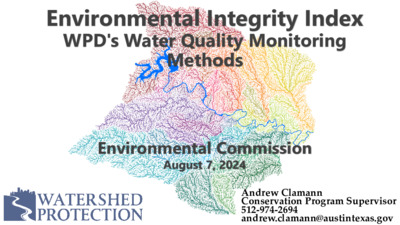20240807-004: Environmental Integrity Index, WPD's Water Quality Monitoring Methods Presentation — original pdf
Backup

Environmental Integrity Index WPD's Water Quality Monitoring Methods Environmental Commission August 7, 2024 Andrew Clamann Conservation Program Supervisor 512-974-2694 andrew.clamann@austintexas.gov 1 Biological indicators Algae Fish Invertebrates Mussels Diversity E.coli and other pathogens Trophic structure Sensitive species Emerging contaminants Pharmaceuticals PAHs PFAS Microplastics Water Quality Hydrocarbons Erosion Turbidity Sedimentation Total Suspended Solids Herbicides Glycophosate Metsulfuron-methyl Conventionals Dissolved Oxygen pH Conductivity Temperature Nutrients Ammonia Nitrogen Phosphorus Metals Arsenic Chromium Mercury Cadmium Arsenic Silver Zinc Lead Nickel Pesticides Chlordane Dieldrin Endrin BHC’s Heptachlor Methoxychlor Environmental Integrity Index (EII) 1994-2024 Six Scoring Categories • Water chemistry • Aquatic Life • Physical Integrity • Contact Recreation • Non-contact Recreation • Sediment Quarterly Water Quality • Field: pH, dissolved oxygen, conductivity, temperature • Lab : Nitrate-N, Ammonia-N, TKN, Orthophosphorus, Turbidity, Total Suspended Solids Contact Recreation • E. coli bacteria Annually Aquatic Life • Benthic macroinvertebrates and Diatoms Non-Contact Recreation • Litter, odor, algae, clarity, etc Habitat • EPA visual assessment (instream & riparian) Sediment Quality • Metals, PAHs, pesticides, herbicides, etc. EII 1994-2008 EII 2008-2024 ~120 sites / 2 yrs ~50 sampled watersheds ~500 miles of creek mainstems ~120 sites / 2 yrs ~50 sampled watersheds ~500 miles of creek mainstems ~5,500 total miles of all creeks Objective retrospect Low resolution, generalized context • • Baseflow only (no stormwater component) • Observational (not statistical) • Not tied to quantifiable solutions Time for a change! Outcomes Drivers Solutions Need a model Empirical Baseflow and Stormflow data 30 years data Cluster sites by GIS similarities model everything, everywhere, all at once • • • physical chemical biological • 3,000 points • updated at will Gridded Surface Subsurface Hydrologic Analysis (GSSHA) GSSHA is a physics-based, distributed, hydrologic, sediment and contaminant fate and transport model that can simulate hydrologic processes in watersheds1 Details provided in QAPP EII 2.0 2 of 4 Hydraulics/Geomorphology 1(Zhang et al., 2023) ~3,000 modeled points along the stream network Points start at 320ac drainage area ~3,000ft apart along the stream network ~3,000 watersheds 9 Routine baseflow sites (remain static) 9 Stormwater sites (change ~5 years) 9 Random sites (change annually) Calibrate Validate Update Random sites Stormwater monitoring (9 sites) • • • • Continuous monitoring of flow and physicochemical (pH, conductivity, etc.) Automatic sample collection through a storm event: (nutrients, total suspended solids, etc.) Sample as many storms as necessary to calibrate the model Annual biological monitoring Routine and Random baseflow monitoring (9 sites) (9 sites) Nutrients, Total Suspended Solids, dissolved oxygen, pH, conductivity, etc • Quarterly sampling: • Annual biological monitoring: Benthic macroinvertebrates, diatoms, etc Entering a new era of scoring and forecasting in an ever changing landscape How does changing ETJ boundaries affect our ability to monitor water quality? Ever changing jurisdictional landscape Senate Bill 2038 (Passed 05/19/2023) • Allows property owners to petition City Clerk for removal from ETJ • Valid petitions are removed from the ETJ after 30 days How does changing ETJ boundaries affect our ability to monitor water quality? Does not change water quality monitoring Does affect water quality spill response Does affect water quality pond inspection Pond Inspection Dam and Safety (PIDS) ETJ Release Tracking Focus on stormwater ponds Challenges of tracking stormwater ponds in the ETJ • Inspecting released properties • Transfer of information to counties • MS4 implications • Uncertainty Focus on stormwater ponds • Receive updates on new releases and cross reference for ponds/violations • Communicate with County • Coordinating with IT Management • Guidance from Law and EV Officer • 51 parcels/properties with ponds removed (as of 7/10/24) • 7 stormwater controls with Notice Of Violation “NOV” information transferred. • Intradepartmental coordination (WPD, DSD, Planning, Law) • Interdepartmental coordination (Policy & Review, Planning, OPM, IT Management) • Interagency coordination (Travis County) Water Quality Compliance (WQC) 24 / 7 / 365 Water Quality Compliance (WQC) • Enforces the City of Austin Water Quality Code Chapter 6-5 • LDC 6-5-11 states that 6-5-12 (Pollution Prohibited) applies in the planning jurisdiction (Full Purpose + ETJ) • In the event of de-annexation, the COA Water Quality Code would no longer apply, but Texas Water Code § 26.121 would still apply regardless – enforceable by County or State Travis County Transportation and Natural Resources Environmental Quality program Goal is to ensure clean and safe water for our communities, and to promote sustainable water management practices through public outreach and education. • Long time partner with COA collecting data in coordination of the Environmental Integrity Index • Monitor creek sites and share data with COA • Currently developing and implementing a new and expanded monitoring program • This initiative aims to improve water quality by conducting regular, comprehensive assessments, and collaborating with other interested agencies to track trends, identify pollution sources, and develop strategies to address potential issues Kiersten Ivy Water Quality Project Manager Kiersten.Ivy@traviscountytx.gov Questions?